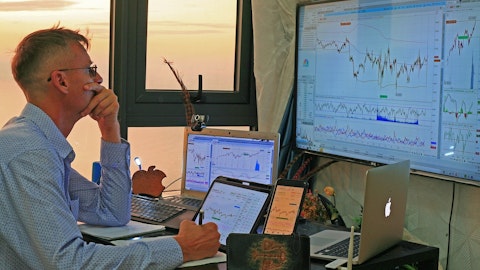Chip Moore: Got it. That’s very helpful. And then another one around the Canon relationship and this outsourcing agreement transferring that this current quarter, right, we’re off pretty much through it, I guess, the current quarter. But how to think about onetime costs or double costs and things like that and when that sort of normalizes. And maybe Mike more for you. Any sense of SG&A and some of the implications there.
Max Munn: We’ve followed a significant number of employees in the legacy manufacturing business. In Kennesaw outside of Atlanta, we have very little duplicate SG&A because the contract with Canon has them invoicing and charging us at shipment. So we have a variable cost structure rather than a fixed cost structure in Atlanta currently. We’re already seeing benefits in reduction of payroll and other SG&A in Atlanta. That’s not an issue that is going to be a negative.
Chip Moore: Got it. Okay. Thanks, Max. And just one last one for me on sort of new product development. I think you talked about going after the shipping and potentially distribution center market more on the food spoilage side. When should we think about that? And how are you going to attack that market? And how do you see that opportunity?
Max Munn: Well, to give you a very short science answer, photo catalytic oxidation, which we’re probably leaders in, likely leaders in that technology, because we’ve been running it for years and it’s the system that’s in the International Space Station and it was a science developed for NASA removes ethylene from the air and it removes ethylene from the air, our air shock product, removes ethylene from the air utilizing photo catalytic oxidation. Ethylene happens to be the chemical in the air that accelerates food spoilage. So, photo catalytic oxidation removes ethylene very effectively and converts it to water vapor and CO2, which are both naturally occurring in the atmosphere. So our systems when they’re in a refrigerated truck or in a refrigerated sea container bringing fruit, berries, flowers from South and Central America and even from California to the East Coast removes ethylene, it significantly increases the shelf life of a valuable post-harvest product.
It’s a proven science, we’re working with Canon to — we’ve had two sea containers delivered to the yard for a tenant in Virginia and we’re working on installing our systems in order to show large sea container companies such as MERSK that our system will significantly reduce the spoilage that they’re currently responsible for while they transport high value post-harvest product. We’re doing a side-by-side video with and without our system, our system in one container and nothing in the other container, both will be loaded with berries and bananas and other high value fruit and vegetables and show what happens over an average four to five day transit time in each of those containers. We know from existing science, science that’s been proven in laboratories and tested at the University of California Davis and in videos that are available on YouTube by an Israeli company who is working on the same issue, but they’re dealing with packaging, which we’re not, shows that in the video specifically that I’m referencing that bananas turn dark brown in four days in transit without photo catalytic oxidation and will last over eight to 10 days with it.
So we know the science is there. We’re going to prove it. We’re going to bring it to the large shipping container companies. Del Monte, for example, has already installed our systems in a 2 million square foot refrigerated warehouse in Atlanta where they bring food in from the West Coast for redistribution. Merck turns out to be a client of Canon, so we’ve got an entry to that introduction.
